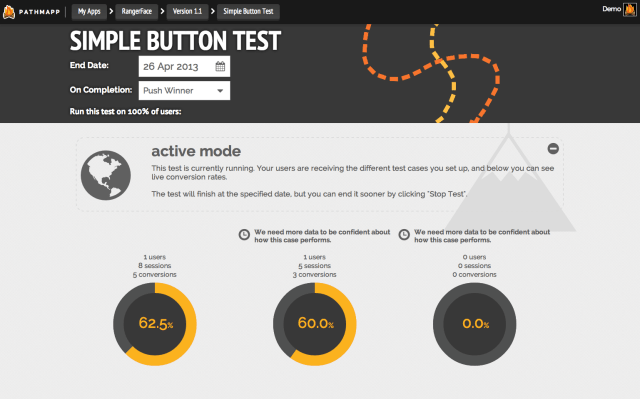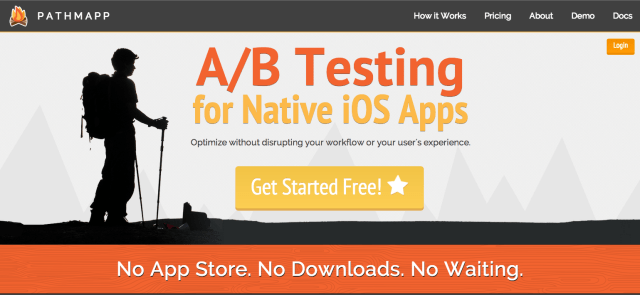A/B testing has long been a fundamental part of developing applications and products for the Web, and, with the explosion of smartphones, developers are naturally eager to use the process to test new designs and updates for mobile apps. The problem is that, traditionally, this has been tricky to manage, especially on iOS given Apple’s approval process, requiring app developers to wait weeks to push new iterations.
Frustrated by the current process, Pathmapp decided to create a solution — one that would allow developers to test different designs and push them out in real time. After debuting at TechCrunch Disrupt San Francisco last year, today, the startup is officially launching an A/B testing platform for native iOS apps that aims to enable mobile developers to optimize their apps and increase conversion without making significant changes to their workflow — or to their users’ experiences.
Born of the founders’ experience building mobile app agency, APPEK, simply put, Pathmapp lets iOS developers create and deploy A/B tests in real time across their native apps without having to resubmit the changes to the App Store. Of course, while Pathmapp co-founder Adam Ceresko admits this may not sound like an earth-shakingly novel concept thanks to the fact that companies like Google and Optimizely have made A/B testing for the web available for years, he believes that no one has yet adequately addressed this problem on mobile.
“As mobile developers, we saw this massive gap in the market,” says Pathmapp CTO Andrew Herman. “Similar technologies have existed on the web for years, but have been sorely lacking in the mobile space since the first iPhone debuted in 2007.”
Since debuting at Disrupt last year, Pathmapp has been running an extended private beta, which came to a close in March. Today marks the beginning of the official public rollout of Pathmapp’s A/B testing platform, but Ceresko tells us that it will be a rolling release, as the startup plans to continue adding new features and tweaking based on user feedback over the next few weeks. The big-picture goal, he says, is to make Pathmapp completely “independent of the web.”
At launch, Pathmapp includes a number of new features that weren’t present in the beta product that the company debuted at Disrupt, chief of which is support for live configuration. In other words, app developers can now use Pathmapp to dynamically change the designs served to users in real time. This means that developers can change the interface of their apps without running an A/B test, bringing support to those who just want to tweak their design.
Pathmapp has also improved its analytics and statistics. It now offers a “confidence measurement” through which it crunches the numbers on user behavior and interaction, telling developers which design performs best among its customers. The idea is to save developers some time from getting wrapped up in data and behavior measurement, allowing them to instead focus on more critical product decisions.
To that end, Pathmapp now also offers the ability to segment users. This enables developers to run a test on a particular subset of users so that they can figure out which design is most effective among a particular group before pushing the change out to one and all. Lastly, Pathmapp is officially introducing A/B/N testing so that developers can try different variations within a single test, rather than having to run hundreds of tests for each small tweak.
In terms of pricing, Pathmapp offers all users a free, 15-day trial, after which Pathmapp starts at $19/month in its “Scout tier,” which is built to accomodate apps of all sizes, ranging from small to enterprise. Those who are looking for greater support and flexibility can upgrade to the startup’s “Pathfinder tier” at $79/month or “Trailblazer” at $399/month.
Pathmapp is developing a fairly simple, easy-to-use solution for app developers hung up on A/B testing for iOS. All they have to do is drop Pathmapp’s SDK into their apps, and they can begin building interfaces right in Xcode, managing the whole process and doing live configurations through their web dashboard.
For more, find Pathmapp at home here.


